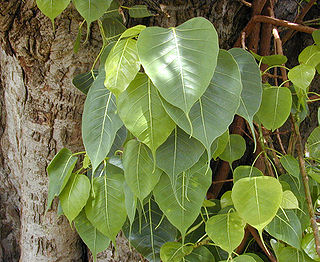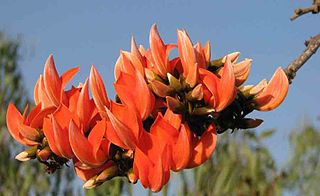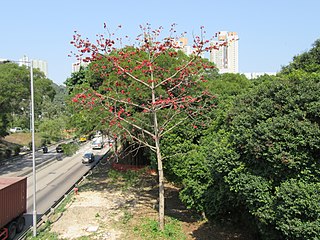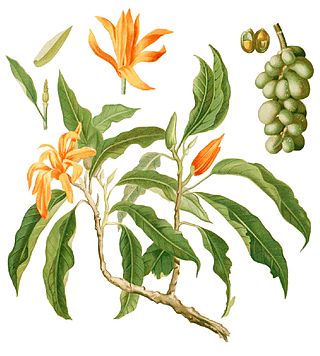
The Bodhi Tree, also called the Mahabodhi Tree, Bo Tree, is a large sacred fig tree located in Bodh Gaya, Bihar, India. Siddhartha Gautama, the spiritual teacher who became known as the Buddha, is said to have attained enlightenment or buddhahood circa 500 BCE under this tree. In religious iconography, the Bodhi Tree is recognizable by its heart-shaped leaves, which are usually prominently displayed.

Tamarind is a leguminous tree bearing edible fruit that is indigenous to tropical Africa and naturalized in Asia. The genus Tamarindus is monotypic, meaning that it contains only this species. It belongs to the family Fabaceae.

Sandalwood is a class of woods from trees in the genus Santalum. The woods are heavy, yellow, and fine-grained, and, unlike many other aromatic woods, they retain their fragrance for decades. Sandalwood oil is extracted from the woods. Sandalwood is often cited as one of the most expensive woods in the world. Both the wood and the oil produce a distinctive fragrance that has been highly valued for centuries. Consequently, some species of these slow-growing trees have suffered over-harvesting in the past.

Baccaurea ramiflora, the Burmese grape, is a slow-growing evergreen tree in the family Phyllanthaceae, growing to 25 m, with a spreading crown and thin bark. It is native to Asia, from Nepal in the west, east to southern China and south to Peninsular Malaysia. It grows in evergreen forests on a wide range of soils. The fruit is harvested and used locally, eaten as a fruit, stewed or made into wine; it is also used medicinally to treat skin diseases. The bark, roots and wood are harvested for medicinal uses.

Jaya Sri Maha Bodhi is a historical sacred bo tree in the Mahamewuna Garden in historical city of Anuradhapura, Sri Lanka. This is believed to be a tree grown from a cutting of the southern branch from the historical sacred bo tree, Sri Maha Bodhi, which was destroyed during the time of Emperor Ashoka the Great, at Buddha Gaya in India, under which Siddhartha Gautama (Buddha) attained Enlightenment. The Buddhist nun Sangamitta Maha Theri, a daughter of Indian Emperor Ashoka, in 236 BC, brought the tree cutting to Sri Lanka during the reign of Sinhalese King Devanampiya Tissa.[1] At more than 2,300 years old, it is the oldest living human-planted tree in the world with a known planting date. The Mahavamsa, or the great chronicle of the Sinhalese, provides an elaborate account of the establishment of the Jaya Siri Maha Bodhi on the Island and the subsequent development of the site as a major Buddhist pilgrimage site.

Ficus religiosa or sacred fig is a species of fig native to the Indian subcontinent and Indochina that belongs to Moraceae, the fig or mulberry family. It is also known as the bodhi tree, peepul tree, peepal tree, pipala tree or ashvattha tree. The sacred fig is considered to have a religious significance in four major religions that originated on the Indian subcontinent: Hinduism, Buddhism, Sikhism and Jainism. Hindu and Jain ascetics consider the species to be sacred and often meditate under it. Gautama Buddha is believed to have attained enlightenment under a tree of this species. The sacred fig is the state tree of the Indian states of Odisha, Bihar and Haryana.

Syzygium cumini, commonly known as Malabar plum, Java plum, black plum, jamun, jaman, jambul, or jambolan, is an evergreen tropical tree in the flowering plant family Myrtaceae, and favored for its fruit, timber, and ornamental value. It is native to the Indian subcontinent and Southeast Asia, including Myanmar, Sri Lanka, Bangladesh and the Andaman Islands. It can reach heights of up to 30 metres (98 ft) and can live more than 100 years. A rapidly growing plant, it is considered an invasive species in many world regions.

Mesua ferrea, the Ceylon ironwood, or cobra saffron, is a species in the family Calophyllaceae native to the Indomalayan realm. This slow-growing tree is named after the heaviness and hardness of its timber. It is widely cultivated as an ornamental for its graceful shape, grayish-green foliage with a beautiful pink to red flush of drooping young leaves, and large, fragrant white flowers. It is the national tree of Sri Lanka, as well as the state tree of Mizoram and state flower of Tripura in India.

Butea monosperma is a species of Butea native to tropical and sub-tropical parts of South Asia and Southeast Asia. It is also known as flame of the forest, Bengal kino, dhak, palash, and bastard teak. Revered as sacred by Hindus, it is prized for producing an abundance of vivid blooms, and it is also cultivated elsewhere as an ornamental.

Bombax ceiba, like other trees of the genus Bombax, is commonly known as cotton tree. More specifically, it is sometimes known as Malabar silk-cotton tree; red silk-cotton; red cotton tree; or ambiguously as silk-cotton or kapok, both of which may also refer to Ceiba pentandra.

Magnolia champaca, known in English as champak, is a large evergreen tree in the family Magnoliaceae. It was previously classified as Michelia champaca. It is known for its fragrant flowers, and its timber used in woodworking.

Colubrina elliptica, also known as mabi or soldierwood, is a species of flowering tree in the family Rhamnaceae that is native to the Florida Keys, the Caribbean, Central America, Mexico, and Venezuela.

Terminalia chebula, commonly known as black- or chebulic myrobalan, is a species of Terminalia, native to South Asia from Pakistan, India and Nepal east to southwest China (Yunnan), and south to Sri Lanka, Malaysia, and Vietnam.

Dalbergia sissoo, known commonly as North Indian rosewood or shisham, is a fast-growing, hardy, deciduous rosewood tree native to the Indian subcontinent and southern Iran. D. sissoo is a large, crooked tree with long, leathery leaves and whitish or pink flowers.

Carya tomentosa, commonly known as mockernut hickory, mockernut, white hickory, whiteheart hickory, hognut, bullnut, is a species of tree in the walnut family Juglandaceae. The most abundant of the hickories, and common in the eastern half of the United States, it is long lived, sometimes reaching the age of 500 years. A straight-growing hickory, a high percentage of its wood is used for products where strength, hardness, and flexibility are needed. The wood makes excellent fuel wood, as well. The leaves turn yellow in Autumn.

Mimusops elengi is a medium-sized evergreen tree found in tropical forests in South Asia, Southeast Asia and northern Australia. English common names include Spanish cherry, medlar, and bullet wood. Its timber is valuable, the fruit is edible, and it is used in traditional medicine. As the trees give thick shade and flowers emit fragrance, it is a prized collection of gardens.

Buchanania cochinchinensis, commonly known as charoli nut, almondette, Cuddapah almond, calumpong, Hamilton mombin, is a deciduous tree of the cashew family. The charoli tree is native to the Indian subcontinent, South Central China, and much of Southeast Asia.

Terminalia arjuna is a tree of the genus Terminalia. It is commonly known as arjuna or arjun tree in English.
The Barandabhar forest covers an area of 87.9 km2 and bisects the Chitwan District in east and west Chitwan. Barandabhar, a 29 km long forest patch, is bisected by the Mahendra Highway, resulting in a 56.9 km2 area in the buffer zone of RCNP and 31 km2 is under the district forest office.

Casearia tomentosa, commonly known as the toothed leaf chilla, is a species of flowering plant in the family Salicaceae, native to the Indian Subcontinent and Myanmar. It is one of 1,000 species that can be found in the Salicaeceae family. Casearia tomentosa has various phytochemical and pharmacological properties that are used in the treatment of many illnesses. It is most notable used in the treatment of seafood poisoning, diabetes, ringworm, and snake bites. Other common names include Bhari, Maun, Churcha, Sonne bethe, and Kakoli based on the region where it is found.




















